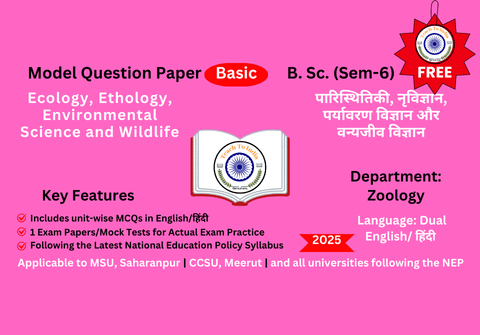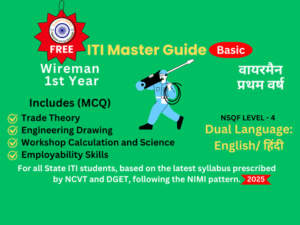Ecology, Ethology, Environmental Science and Wildlife - पारिस्थितिकी, नृविज्ञान, पर्यावरण विज्ञान और वन्यजीव विज्ञान
- Description
- Curriculum
- Reviews

Model Question Paper
Ecology, Ethology, Environmental Science and Wildlife – पारिस्थितिकी, नृविज्ञान, पर्यावरण विज्ञान और वन्यजीव विज्ञान
Key Features | मुख्य विशेषताएँ
- Bilingual Model Paper | द्विभाषी मॉडल पेपर
- Enough MCQ for Practice | अभ्यास के लिए पर्याप्त MCQ
- Exam Practice Paper with Mock Tests | मॉक टेस्ट के साथ परीक्षा अभ्यास पत्र
- Latest Syllabus as per NEP | NEP के अनुसार नवीनतम पाठ्यक्रम
- Designed by Experts | विशेषज्ञों द्वारा तैयार किया गया
The given MCQs cover only 10% of the syllabus | दिए गए बहुविकल्पीय प्रश्न केवल 10% पाठ्यक्रम को कवर करते हैं।
To cover 100% of the syllabus with summaries, upgrade to our Advanced Model Paper.| पूरा सिलेबस और सारांश कवर करने के लिए हमारा एडवांस मॉडल पेपर जॉइन करें। Join Advanced Model Paper
|
Program Class: Degree / B.Sc |
Year: Third |
Semester: Six |
||
|
Subject: ZOOLOGY |
||||
|
Course Title: Ecology, Ethology, Environmental Science and Wildlife |
||||
|
Course Learning Outcomes: On completion of this course, learners will be able to: · Complexities and interconnectedness of various environmental levels and their functioning. · Global environmental issues, their causes, consequences and amelioration. · To understand and identify behaviours in a variety of taxa. · The proximate and ultimate causes of various behaviours. · About the molecules, cells, and systems of biological timing systems. · Conceptualizing how species profitably inhabit in the temporal environment and space out their activities at different times of the day and seasons. · To interpret the cause and effect of lifestyle disorders contributing to public understanding of biological timing. · To understand the importance of wildlife conservation. |
||||
|
Credits: 4 |
Core Compulsory |
|||
|
Max. Marks: –25+75 |
Min. Passing Marks: 33 |
|||
|
Unit |
Topics |
|||
|
I |
Introduction to Ecology · History of ecology, Autecology and synecology, · Levels of organization, Laws of limiting factors, · Study of physical factors |
|||
|
II |
Organization of Ecosystem · Levels of organization, Laws of limiting factors, Study of physical factors, · Population: Density, natality, mortality, life tables, fecundity tables, survivorship curves, age ratio, sex ratio, dispersal and dispersion ,Exponential and logistic growth, · Types of ecosystems with one example in detail, Food chain: Detritus and grazing food chains, , Food web, Energy flow through the ecosystem, · Ecological pyramids and Ecological efficiencies, Nutrient and biogeochemical cycle with one example of Carbon cycle |
|||
|
III |
Community Ecology Community characteristics: species richness, dominance, diversity, abundance, Ecological succession with one example |
|||
|
IV |
Environmental Hazards · Sources of Environmental hazards · Climate changes. Basics of environmental impact assesement · Greenhouse gases and global warming · Acid rain, Ozone layer destruction |
|||
|
V |
Effects of Climate Change · Effect of climate change on public health · Sources of waste, types and characteristics, Sewage disposal and its management, Solid waste disposal, Biomedical waste handling and disposal, · Nuclear waste handling and disposal, Waste from thermal power plants, · Case histories on Bhopal gas tragedy, Chernobyl disaster and their aftermath. |
|||
|
VI |
Behavioural Ecology and Chronobiology · Origin and history of Ethology, · Instinct vs. Learnt Behaviour · Associative learning, classical and operant conditioning, Habituation, Imprinting, · Biological clocks, Circadian rhythms; Tidal rhythms and Lunar rhythms, circannual rhythms · Chronomedicine |
|||
|
VII |
Introduction to Wild Life · Values of wild life – positive and negative; Conservation ethics; Importance of conservation; Causes of depletion; World conservation strategies. |
|||
|
VIII |
Protected areas · National parks & sanctuaries, Community reserve; Important features of protected areas in India; Tiger conservation – Tiger reserves in India; Management challenges in Tiger reserve |
|||
-
1Unit 1: MCQs - Ecology, Ethology, Environmental Science and Wildlife
-
2Unit 2: MCQs - Ecology, Ethology, Environmental Science and Wildlife
-
3Unit 3: MCQs - Ecology, Ethology, Environmental Science and Wildlife
-
4Unit 4: MCQs - Ecology, Ethology, Environmental Science and Wildlife
-
5Unit 5: MCQs - Ecology, Ethology, Environmental Science and Wildlife
-
6Unit 6: MCQs - Ecology, Ethology, Environmental Science and Wildlife
-
7Unit 7: MCQs - Ecology, Ethology, Environmental Science and Wildlife
-
8Unit 8: MCQs - Ecology, Ethology, Environmental Science and Wildlife







